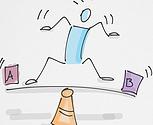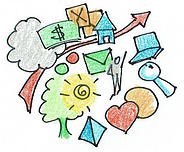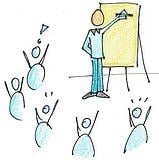“Anyone can make the simple complicated. Creativity is making the complicated simple” (Charles Mingus)
You don’t want me to do that, and I wouldn’t, if not out of necessity, believe me.
Once upon a time not long ago, you were requested to do something you wouldn’t do on purpose or even remotely willingly: “John, we need you at the next board meeting on Friday.” Your boss shouts at you, “Please prepare to present our status on the product-strategy, projects, risks and chances, suppliers, clients and so on, you know…”
Immediately, you feel that chill creeping down your spine. The one, unmistakably approaching at times, when something you fear for a reason is going to happen soon.
In front of your eye the following scene unfolds:
Board meetings are one of a kind. They’re lengthy, aiming at — what exactly? Everyone wants to be in the loop about what has happened recently, right? Many, I mean many PowerPoint slides are needed. Up to two hours presenting many numbers, complex correlations of business-processes, projects, suppliers and so on.
After a short while in any of that meetings, the audience, especially on Friday afternoons, tend to do the following:
- Being unable to follow up
- Getting bored
- Fall asleep
You wish more than anything at that point there would be a way out. Any easier approach, something doable at least would do just well.
Rest assured, there is a surprisingly helpful approach to the rescue.
- You will calm your fears of presenting many slides on a Friday
- Get back the control over your audience
- Stop the audience from getting bored in the first place
- Even better, make them remember your presentation and engage with you
What’s happening?
As Antonio Zamora, entrepreneur and founder of Wimz.ch puts it:
“Take a pen, and the audience switches to the same level as you. Even accepting, you are being the teacher in the room now.”
In 3 steps, I’m now going to tell you, how you can approach the audience visually and tackle a complex scenario. Creating an image to tell a story will help a lot to attract and engage the audience.
1. Learn about your “story”
Message, Content and Visuals are the three essential parts of any successful presentation. Make sure you invest all your knowledge and of course, your creativity to form a substantial body of your play.
Do as much as you can, to become an expert about what you will present.
Studies from Eyeful Presentations show that most presenters have either 1 to 2 hours or a day and more time to prepare for a presentation.
One way or the other, the most crucial part will be the message. Invest slightly more to what is the central story you want to tell your audience. The other two go as equal parts to the content and visuals.
2. Visualize your play
In our example from the beginning, we have many topics to cover. Let’s do it:
- Product-Strategy
- Projects
- Risks and chances
- Suppliers
- Clients
Assuming, those being the main topics, you need to create an image with them as integral parts.
Wow, I hear you say, how on earth should I do that.
Well, the bad news is: there will be no golden rule for how doing it.
On the positive side, you can always challenge yourself. In this example, I show you, there is no rocket science part in it either.
Product-strategy can mean many things, mostly it’s something not razor sharp. Hopefully for most of you guys, it’s there, but could equally well exist in a cloud. So why not using that to visualize it?
Who better than you know, that projects always are like a long road. They will have milestones in it and a beginning and an end.
Well, scribble a path or road. Why not place any trees on its sides? How’s that, not too hard, right?
Risks are always something, business professionals fear. For that reason it can be something like an animal that occasionally crosses your path, and you won’t be happy to spot it. A wolf? Yes, why not.
Chances are what makes your day, they’re shiny and bright, like the sun sometimes.
A supplier provides products or parts for your company, and the cute Little Red Riding Hood would be just great to visualize just that.
The clients are nice people all your business is about. They mark the end, or as well the beginning of the road and may live in lovely little homes.
3. Draw
See what we did? We created pieces of scenery that even preschoolers could paint. My point is, in no case be too hard with yourself if you now paint that story.
Take a piece of paper and combine those little parts in one image. Even better, grab your whiteboard for a spin and just do it.
After a couple of times trying, you will feel it. The story and with it a remarkable start of your upcoming meeting will visualize in front of you.
Of course you guessed it: In the end this would make a beautiful scene of the well known fairy-tail The Red Riding Hood.
Example Visualization
The following graphics show you even better that you don’t need to be an artist to visualize a great deal of information. Likewise, it’s doable even without being a creativity wizard to start using the drawing for business use-cases.
Background
Why does it all work that way? The scientific reasoning has a lot to do with how we perceive ourselves and the environment. How do we process and digest that information, learn and communicate with each other?
Neuro-Linguistic Programming or NLP is that discipline of the cognitive and behavioral science, that deals with us being subjective humans.
According to the Business Directory, it even provides the pattern, how words and symbols are used to create mental pictures that our senses use to process the according experience later stored in the brain.
Please find out more here and here.
















































